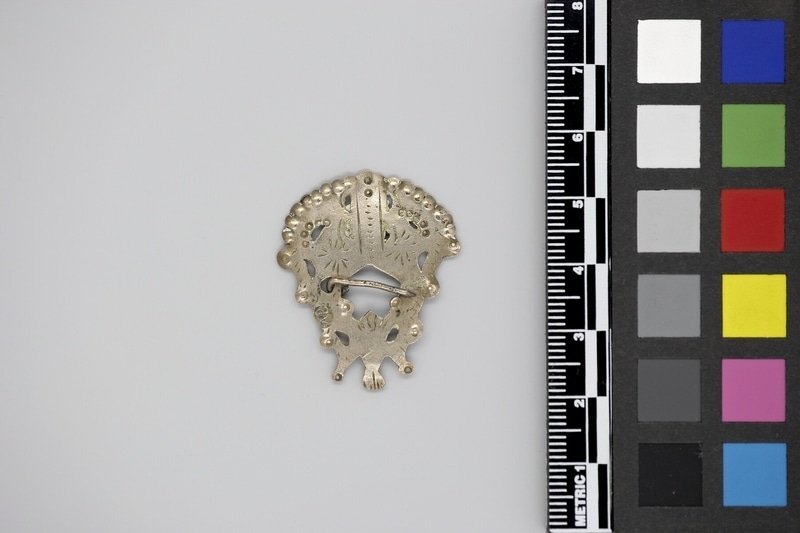Brooch Item Number: 1590/236 from the MOA: University of British Columbia

Description
Masonic-shape brooch with raised bosses on edges, one semi-circular cutout on each side of the top half, four semi-circular cutouts on each side of the bottom half and irregular-shaped cutouts in the centre. Engraved decorations and punch marks. Maker’s hallmark in round cartouche. Cross-pin turned through small circular cutout on edge of large cutout.
History Of Use
Silver ornaments represent an important part of early exchange between Europeans, including fur traders, and First Nations peoples, especially in eastern and central Canada and the U.S.A. Initially, the main source of silver was British, French and Spanish coins. Most ornaments were produced by silversmiths of European origin in North America and Europe, and were actively traded only from 1760 to 1821. By the mid-18th century silver objects were produced in New England, Quebec and Montreal. Silver was used by First Nations peoples as a sign of rank. Silver ornaments in these styles continue to be produced by native silversmiths in central Canada and the U.S.A. Brooches were the most popular and numerous silver ornaments. They were worn on the chest, but also in the hair. Frequently, many were worn at once in rows across the chest. The Masonic-type brooch may have been introduced by Mohawk Iroquois Chief, Joseph Brant, who in 1775 became a member of the Masonic Order in London.
Cultural Context
trade; personal decoration; status
Specific Techniques
Repousse is a type of ornamentation formed in relief in metal by hammering up from the reverse or inner side.
Item History
- Made by Adrian Banker (Maker) in New York, New York, USA between 1760 and 1821
- Owned by Kathleen E. Reif before September 9, 1993
- Received from Kathleen E. Reif (Donor) on September 9, 1993
What
Who
- Culture
- Eastern Woodlands
- Creator
- Adrian Banker (Maker)
- Previous Owner
- Kathleen E. Reif
- Received from
- Kathleen E. Reif (Donor)
Where
- Holding Institution
- MOA: University of British Columbia
- Made in
- New York, New York, USA
When
- Creation Date
- between 1760 and 1821
- Ownership Date
- before September 9, 1993
- Acquisition Date
- on September 9, 1993
Other
- Item Classes
- metalwork
- Condition
- good
- Accession Number
- 1590/0236